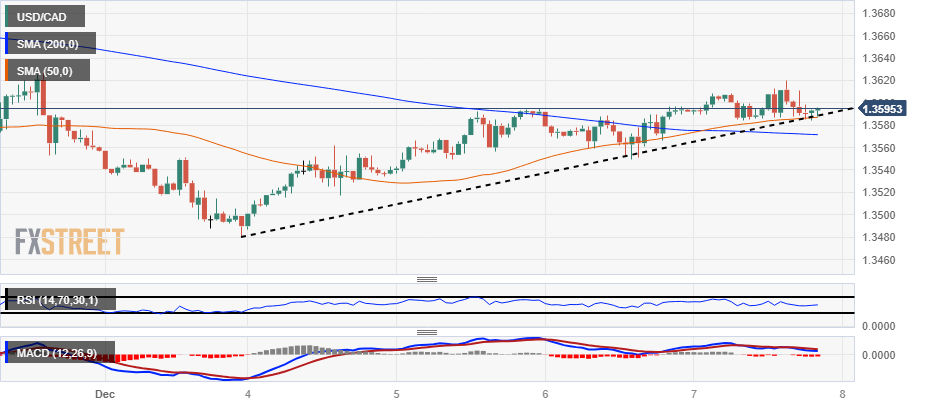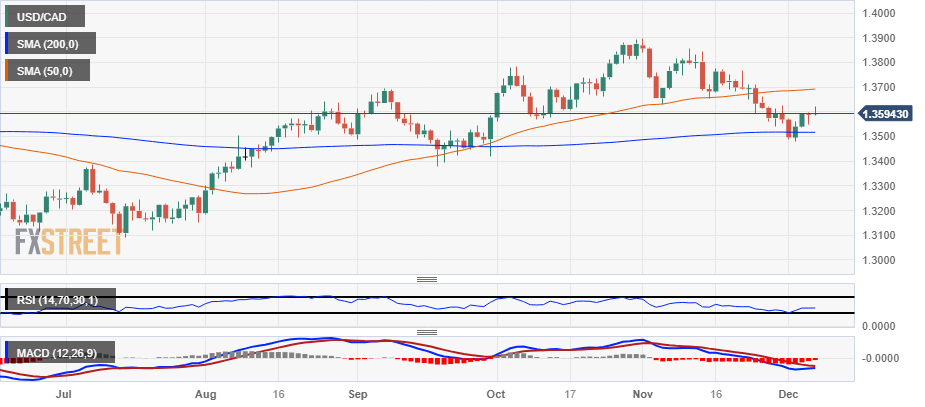Canadian Dollar one of the weakest performers on Thursday as US NFP looms ahead

- The Canadian Dollar is lower on the day against most of its peers.
- Crude Oil prices appear to have found a floor for now, easing downside CAD pressure.
- Friday’s US NFP remains the key closer for the trading week.
The Canadian Dollar (CAD) continues to pare back recent gains, shedding weight or flattening against all of its major currency peers, losing ground across the entire FX major currency board.
The Bank of Canada (BoC) held interest rates steady at 5% on Wednesday, in-line with market expectations and bolstering the Canadian Dollar on the day. Now that investors have had time to chew on the BoC’s statement, it seems the Canadian central bank wasn’t as hawkish as it initially appeared.
The Canadian Dollar is paring back gains on Thursday as investors readjust their CAD exposure heading into another bumper US Nonfarm Payrolls (NFP) print to close out the trading week on Friday.
Daily Digest Market Movers: Canadian Dollar softer as markets focus on US NFP ahead
- Thin data on the docket for Thursday as markets get a breather before Friday’s NFP print.
- Canadian Building Permits recovered less than markets were hoping for in October, rebounding 2.3% versus the forecast of 2.9%.
- September Building Permits declined -8.1% after getting revised down from -6.5%.
- US Initial Jobless Claims for the week ending December 1 slightly beat expectations, helping to bolster equities and risk appetite in general, limiting CAD losses.
- US Initial Jobless Claims saw 220K new jobless benefits seekers last week, slightly less than the forecasted 222K and coming in just under the 4-week average of 220.75K.
- Crude Oil markets have flattened on Thursday but remain steeply off of recent bids, providing little support for the Canadian Dollar.
- Markets to focus on Friday’s upcoming US Nonfarm Payrolls report for November, expected to climb from October’s 150K to 180K MoM.
Canadian Dollar price today
The table below shows the percentage change of Canadian Dollar (CAD) against listed major currencies today. Canadian Dollar was the strongest against the Swiss Franc.
| USD | EUR | GBP | CAD | AUD | JPY | NZD | CHF | |
| USD | -0.34% | -0.27% | 0.01% | -0.83% | -2.46% | -0.56% | 0.02% | |
| EUR | 0.34% | 0.03% | 0.33% | -0.50% | -2.11% | -0.23% | 0.36% | |
| GBP | 0.29% | -0.05% | 0.29% | -0.54% | -2.16% | -0.27% | 0.30% | |
| CAD | -0.01% | -0.33% | -0.29% | -0.84% | -2.46% | -0.57% | 0.00% | |
| AUD | 0.82% | 0.51% | 0.53% | 0.83% | -1.61% | 0.28% | 0.84% | |
| JPY | 2.40% | 2.09% | 2.12% | 2.44% | 1.58% | 1.88% | 2.42% | |
| NZD | 0.56% | 0.23% | 0.27% | 0.56% | -0.27% | -1.91% | 0.57% | |
| CHF | 0.00% | -0.34% | -0.31% | -0.01% | -0.85% | -2.48% | -0.58% |
The heat map shows percentage changes of major currencies against each other. The base currency is picked from the left column, while the quote currency is picked from the top row. For example, if you pick the Euro from the left column and move along the horizontal line to the Japanese Yen, the percentage change displayed in the box will represent EUR (base)/JPY (quote).
Technical Analysis: Canadian Dollar sees downside on Thursday, USD/CAD testing 1.3600
The USD/CAD pushed back into the 1.3600 handle during Thursday trading, and the pair is running into some resistance in the bids at the technical level. A rebound in the Loonie looks unlikely with intraday action finding support from the 200-hour Simple Moving Average (SMA) near 1.3570.
On the daily candlesticks, the USD/CAD is being pushed higher following a rejection from the 200-day SMA just above the 1.3500 handle. Near-term action sees the 50-day SMA testing 1.3700, which could draw bids higher.
A sustained bearish rejection from 1.3600 will see downside momentum gather for a run back down to 1.3500, where sellers will want to regather efforts for an attempt at breaking through the week’s low near 1.3480.
USD/CAD Hourly Chart
USD/CAD Daily Chart

Nonfarm Payrolls FAQs
Nonfarm Payrolls (NFP) are part of the US Bureau of Labor Statistics monthly jobs report. The Nonfarm Payrolls component specifically measures the change in the number of people employed in the US during the previous month, excluding the farming industry.
The Nonfarm Payrolls figure can influence the decisions of the Federal Reserve by providing a measure of how successfully the Fed is meeting its mandate of fostering full employment and 2% inflation.
A relatively high NFP figure means more people are in employment, earning more money and therefore probably spending more. A relatively low Nonfarm Payrolls’ result, on the either hand, could mean people are struggling to find work.
The Fed will typically raise interest rates to combat high inflation triggered by low unemployment, and lower them to stimulate a stagnant labor market.
Nonfarm Payrolls generally have a positive correlation with the US Dollar. This means when payrolls’ figures come out higher-than-expected the USD tends to rally and vice versa when they are lower.
NFPs influence the US Dollar by virtue of their impact on inflation, monetary policy expectations and interest rates. A higher NFP usually means the Federal Reserve will be more tight in its monetary policy, supporting the USD.
Nonfarm Payrolls are generally negatively-correlated with the price of Gold. This means a higher-than-expected payrolls’ figure will have a depressing effect on the Gold price and vice versa.
Higher NFP generally has a positive effect on the value of the USD, and like most major commodities Gold is priced in US Dollars. If the USD gains in value, therefore, it requires less Dollars to buy an ounce of Gold.
Also, higher interest rates (typically helped higher NFPs) also lessen the attractiveness of Gold as an investment compared to staying in cash, where the money will at least earn interest.
Nonfarm Payrolls is only one component within a bigger jobs report and it can be overshadowed by the other components.
At times, when NFP come out higher-than-forecast, but the Average Weekly Earnings is lower than expected, the market has ignored the potentially inflationary effect of the headline result and interpreted the fall in earnings as deflationary.
The Participation Rate and the Average Weekly Hours components can also influence the market reaction, but only in seldom events like the “Great Resignation” or the Global Financial Crisis.
